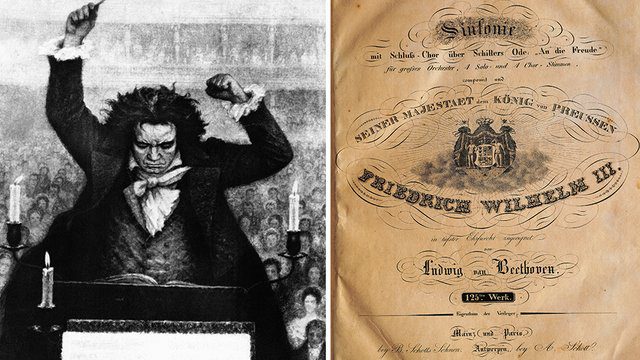
As the curtain rises on the bicentennial anniversary of Ludwig van Beethoven’s Symphony No. 9, we find ourselves celebrating a masterpiece that has reverberated through history with the power of a thousand orchestras. This monumental symphony, also known as the “Choral Symphony,” premiered on May 7, 1824, in Vienna, and its legacy is nothing short of extraordinary.
Beethoven’s Ninth Symphony isn’t just music; it’s a universe of sound, feeling, and thought, encapsulating the composer’s vision of humanity and hope. The inclusion of a choir in the final movement, singing Friedrich Schiller’s “Ode to Joy,” was a stroke of genius, resonating with Beethoven’s ideal of universal brotherhood. This iconic symphony blends vocal and symphonic elements in a way that was revolutionary at the time, setting a new standard for classical music.
Beyond its innovative structure and melodic brilliance, the Ninth Symphony carries a profound message. Composed during a time of turmoil in Europe, the symphony became a beacon of hope amidst the chaos, echoing Beethoven’s belief in humanity’s potential for redemption and collective joy. The symphony’s triumphant and hopeful conclusion, culminating in the famous “Ode to Joy,” reflects a vision of humanity united in peace and brotherhood.
The story behind the symphony’s premiere is equally remarkable. Despite his complete deafness, Beethoven conducted the first performance, unaware of the audience’s rapturous response until one of the musicians turned him around to face their applause. The Ninth Symphony stands as a testament to Beethoven’s resilience and unwavering dedication to his art, embodying his triumph over adversity.
The Inception of a Masterpiece
One fascinating tidbit about Beethoven’s Symphony No. 9 is that it was commissioned by the Philharmonic Society of London as early as 1817, with the key set in D minor and vocal participation forecasted. The composition work was completed in February 1824. Before the Ninth Symphony, Beethoven experimented with vocal and instrumental combinations in his 1808 “Choral Fantasy,” Op. 80.
The Premiere’s Unique Ensemble
The premiere of Beethoven’s Ninth Symphony was an event of massive proportions, involving the largest orchestra Beethoven ever assembled. It required the efforts of the Kärntnertor house orchestra, the Vienna Music Society, and a group of talented amateurs. Prominent musicians such as Franz Schubert and Carl Czerny were present, and Beethoven personally recruited renowned singers like Henriette Sontag and Caroline Unger.
The Symphony’s Evolving Structure
Originally, Beethoven considered creating two symphonies from the Ninth due to its expansive structure. However, he decided to pour all his energy into the final movement, resulting in a work that stretched conventional forms to their limits. The finale is longer than any other single movement in the symphony, creating an imbalance but also serving as a testament to Beethoven’s boundless creative ambition.
The ‘Ode to Joy’ Phenomenon
Beethoven’s choice to set Schiller’s “Ode to Joy” was a masterstroke. The poem speaks of universal brotherhood, and its sentiment echoed Beethoven’s feelings about humanity. The melody has since been adopted as the European Union’s anthem, embodying ideals of freedom, peace, and solidarity.
A Message for the Ages
The Ninth Symphony carries a message of hope and unity. It’s often seen as a farewell to the oppressive Napoleonic regime under which Beethoven lived and a celebration of humanity’s ability to overcome struggles. The symphony’s impact has been enduring, as it continues to resonate with audiences seeking solace and inspiration in times of uncertainty.
A Triumph of the Human Spirit
Beethoven’s Ninth Symphony is a triumph of the human spirit. Despite being almost completely deaf, Beethoven crafted a complex and intricate work that symbolizes his resilience. The symphony’s journey to creation was as romantic as the work itself, reflecting the enduring human spirit and inspiring listeners to appreciate what they have to be grateful for.
The Symphony’s Influence
Richard Wagner famously described Beethoven’s Ninth as a “universal artwork,” weaving together various artistic forms of expression and unlocking the limitless potential of symphonic music. The symphony’s influence on subsequent composers was immense, inspiring countless interpretations and reinterpretations of its themes and ideas.
Beethoven’s Unique Innovations
One of the most innovative aspects of Beethoven’s Ninth is the inclusion of a poetic text sung by solo and choral voices, which brought specific dramatic meaning to the musical journey. The finale ingeniously conveys the story of Schiller’s “Ode to Joy” using rhetorical devices, theme-and-variation, fugue, and sonata-allegro form, creating a unique and innovative structure.
The Cultural Impact
The Ninth Symphony has had a profound cultural impact, being used in ceremonies and celebrations, and even in outer space. It was played to commemorate the fall of the Berlin Wall and has become a symbol of global unity and peace. The symphony’s iconic status is further cemented by its groundbreaking integration of vocal and symphonic elements and its message of universal brotherhood.
In essence, Beethoven’s Ninth Symphony is a journey through the vast expanse of human experience, from desolation to redemption, from chaos to cosmic harmony. It’s a reminder of our collective humanity and the hope that lies within us all. So, as we celebrate this bicentennial milestone, let’s raise our glasses to Beethoven and his enduring masterpiece, a symphony that transcends time and continues to inspire generations.












Leave a Reply